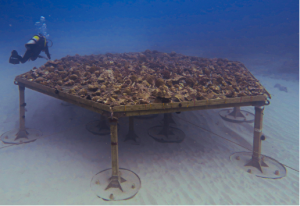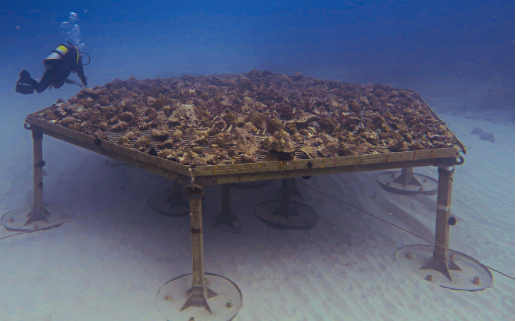Coral Stress and Conservation
By Morgan Asmussen, SRC intern
The oceans are vital to Earth and its inhabitants as it covers more than seventy percent of the planet and holds about ninety-seven percent of Earth’s water. Climate change, however, is linked to human habits and activity in our daily lives. Climate change occurs with the increase of greenhouse gases due to human activities that involve the burning of fossil fuels for sources of heat and energy, the production of industrial products, raising livestock, fertilizing crops and even deforestation (Trenberth 2001). All of these human activities then cause a buildup of greenhouse gases to heat up our atmosphere. With rising composition of gases in the atmosphere causes the ocean to absorb an excess amount of carbon dioxide and methane leading to many consequences specifically impacting the survivability of coral species on a global scale.
The ocean regulates global climate and makes the Earth habitable for humans and all of its inhabitants. Carbon dioxide levels that have been measured in Earth’s atmosphere have been at an all-time high and most likely ties to human activity (Rogers 2018). The greenhouse effect is then amplified due to the large amount of gases such as carbon dioxide and methane which hold heat within the atmosphere and warm the Earth. Initially this was seen as beneficial for Earth as a large diverse population of species was then able to flourish at warm temperatures. However, as time went on and temperatures continued to rise, the presence of greenhouse gases rose almost thirty percent (Rogers 2018). Earth contains absorbent oceans which trap this heat and prevent it from reaching uninhabitable temperatures. With higher values of carbon dioxide, the chemistry of the ocean then began to alter which inevitably effected its inhabitants. With rising gas comes ocean acidification leading to a decrease in growth rates and structural integrity of coral reefs.
A warming ocean puts more thermal stress on its organisms causing corals to bleach. Raising the oceans’ temperatures just a few degrees Celsius can cause coral to die. It is similar to human response to an unknown threat. Humans produce a fever and attempt to flush the body as rapidly as possible to remove any foreign bodies. Corals do the same when it comes to a rise in temperature of the waters in which they live in. When the temperature of water rises, corals flush out the essential algae within their polyps as a response to the stress. These algae produce food for the corals, therefore, when corals no longer have access to this symbiotic relationship they begin to bleach. With excess bleaching of coral species comes devastation of marine ecosystems and eventually a negative impact to humankind’s lifestyle, food sources, and living environment as these changes will not just be detrimental to corals and other marine species (Poloczanska et al. 2013).
One of the most widely used procedures of coral conservation and restoration that has been implemented is coral nurseries and transplants which has been utilized to restore coral populations. Coral transplants are a growing practice in which researchers restore old, dead coral with healthy coral grown by humans. Although this has been successful in many locations, scientists found that transplantation of coral fragments is best utilized when there is (1) a “phase shift” within the communities that have been dominated by soft corals and/or macroalgae which limits the hard corals access to sunlight, (2) natural recruitment is limited within the colony at hand, (3) when donor coral colonies are available and healthy, and (4) when the water quality is favorable in order to promote growth and survival of the donor coral (Rinkevich 2005).

Coral Fragment (Source: Meaghan Johnson, Coraldigest.com)
Corals themselves are vital for the ocean’s ecosystems to survive but they also provide many health benefits for humans. It has been found that corals have possible cancer fighting components. For instance, there is currently a drug called prostaglandin that comes from sea fans and another drug called bryostatin that comes from coral rhizomes which also fights cancer. There has been other medicinal product as a result of marine organisms which have helped researchers with diseases such as Alzheimer’s disease, arthritis and heart disease. Humankind has only explored about eight percent of all world oceans and it has already provided the human species with so much to benefit their health. There is so much that coral reefs have to offer making them even more vital for not just human survival but all species survival. Coral reefs provide includes their ability to serve as a natural breakwater that protects people from large waves and dangerous cyclones that might have otherwise devastated the United States of America’s coastlines. Coral breakwaters are proven to be better than the ones that man can produce, because they’re growing and rebuilding themselves at all the times (Tobler 2012).

Coral Nursery (Source: NOAA Fisheries, www.fisheries.noaa.gov)
Thirty-eight million people worldwide are currently employed by the fish industry would then left be jobless if there was a devastation if coral and fish populations which may be a reality on the current path Earth and its atmosphere is on. The Caribbean would lose its main source of income if corals were to disappear which would leave people with nowhere to turn. Even human health would suffer due to the medical benefits that corals provide and the advancements the medical world has found through animal species such as sea cucumbers, jellyfish and as discussed previously, coral. There would be complete disruption of biodiversity most likely resulting in mass extinction throughout the animal kingdom (Richardson 2012). Over 62 million people would no longer have the surge protection that corals provide from rises sea level and numerous other unfathomable losses our planet won’t be able to sustain due to coral extinction.
Coral restoration and conservation are essential for the survival of ocean ecosystems and human economies worldwide. Practices such as transplants and coral nurseries are necessary procedures in attempt to reverse the anthropogenic effects of climate change. They have become very common within the marine science field and support the recovery of the oceans.
Works Cited
Poloczanska ES, Brown CJ, Sydeman WJ; Kiessling W and Schoeman DS. (2013). Global imprint of climate change on marine life. Nature Climate Change 10:919-925
Rogers JW (2018) Climate Change: Science and Threats. The Ocean Portal 2:1-12
Richardson AJ, Brown CJ, Brander K, Bruno JF and Buckley L. (2012). Climate change and marine life. Biology Letters 8:907-909
Rinkevich, Baruch. “Conservation of Coral Reefs through Active Restoration Measures: Recent Approaches and Last Decade Progress.” Environmental Science & Technology, vol. 39, no. 12, 2005, pp. 4333–4342.
Tobler C, Visschers VH and Siegerist M. (2012). Consumers’ knowledge about climate change. Dordrecht 114:189-209
Trenberth KE (2001) Stronger evidence of human influence on climate: The 2001 IPCC assessment. Environment 43:8-10



